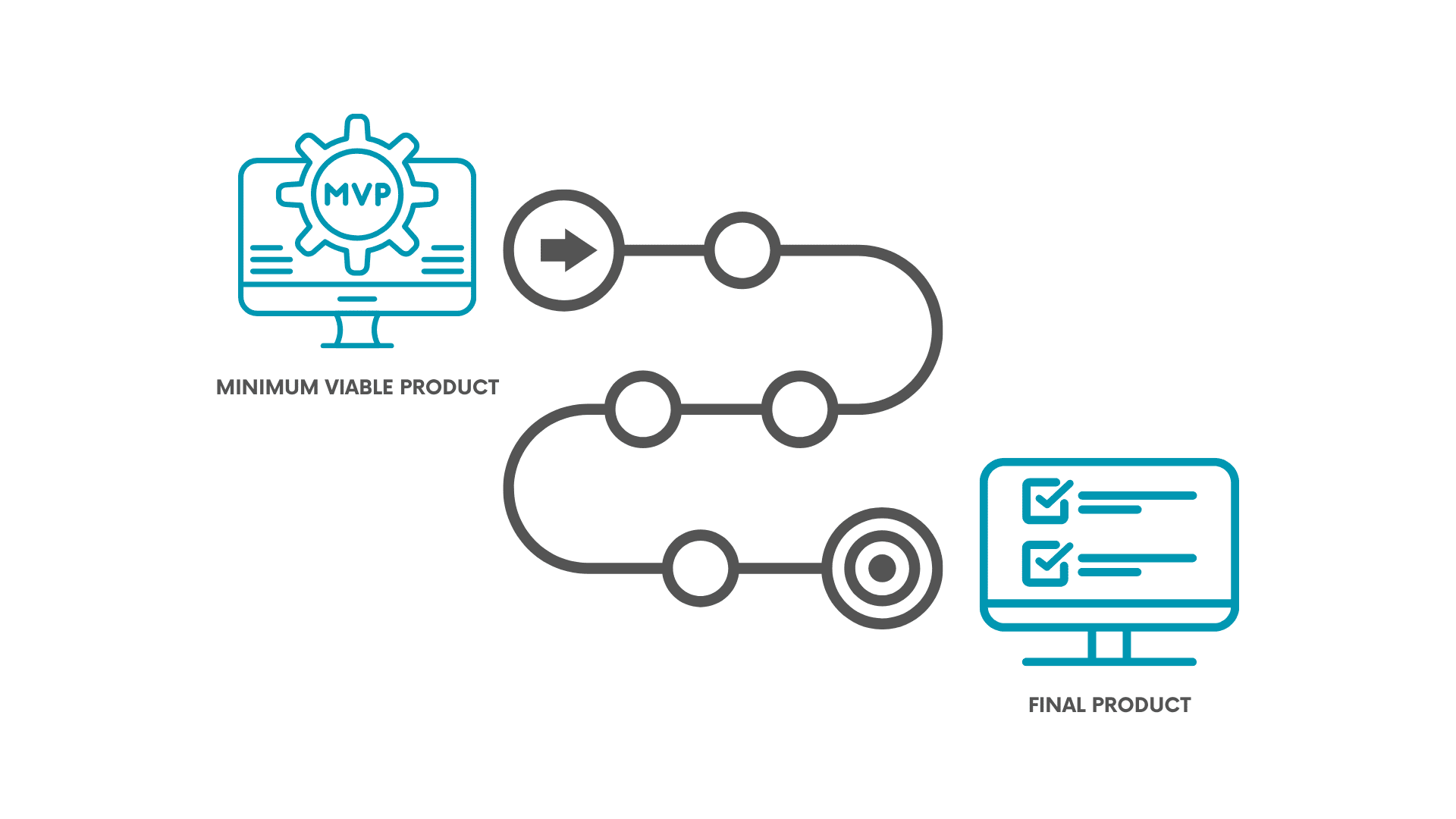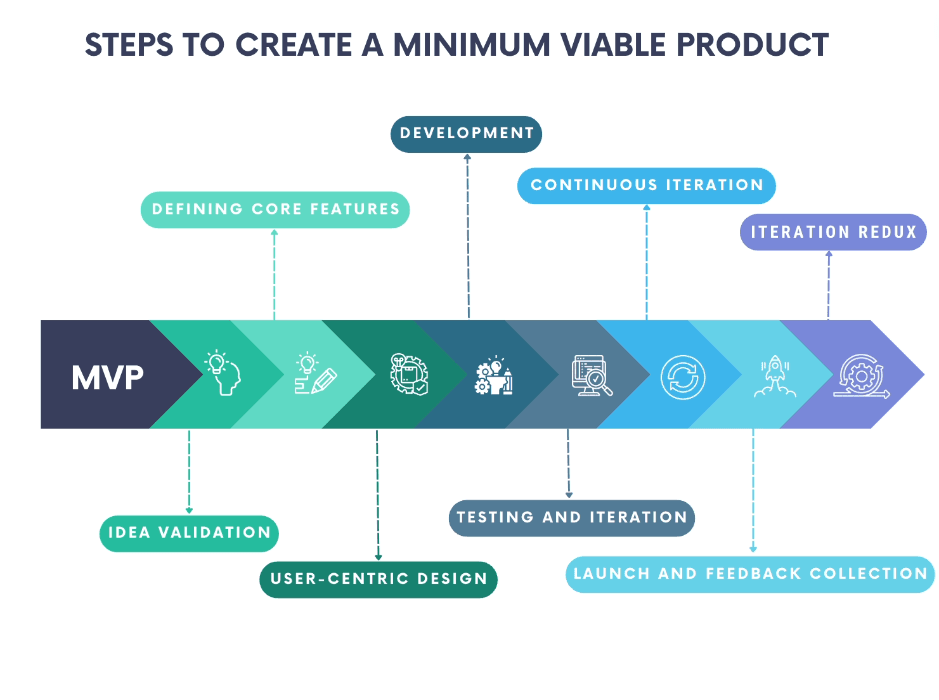What is a Minimum Viable Product / MVP

About us
MoldoWEB is a software development company, located in Romania, specialized in providing outsourcing and team augmentation services for clients around the world.
Table of contents
- Definition of Minimum Viable Product (MVP)
- Importance of MVP in Product Development
- Main Advantages of an MVP
- What Are the Essentials for a Great MVP?
- Steps to Create an MVP
- Conclusion
Do you have a new app or product idea but aren’t sure if it will be successful? In that situation, it might be smart to create an MVP (Minimum Viable Product) first. MVPs are simplified versions of a product or app, and what’s really great about them is that they don’t need a big investment upfront. This way, when developing a product, you get to focus only on the core features first, which will help you improve it as you go, based on reviews and recommendations.
In today’s article, we will take a closer look at MVPs and their advantages, and why they’re worth considering when working on a new product.
Definition of Minimum Viable Product (MVP)
Imagine the MVP as the first draft of your product. It’s far from the final version and consists of only the most basic and core features. An MVP covers only the most important needs of your users, without any extra added at the beginning.
The main idea behind the MVP is to keep things simple. With the help of the right development team, you can make sure to create and launch a product quickly and improve it as you go. This way, you get to create a product with minimal investment, then, adjust or improve it based on what you learn from your audience.

Importance of MVP in Product Development
Starting with an MVP is a quite popular practice in software development. It allows companies to build a basic product, quickly launch and test it first, draw conclusions, and make decisions based on these insights for what’s next.
One of the biggest advantages of an MVP is that it lets you test your ideas early on, without too much time and money investment. It can be a time-consuming process to develop a full product with all the features you imagined, especially if you’re not sure about the outcome. With a Minimum Viable Product, you get to take things step-by-step, starting with a simple version. If something is not working well or needs adjustments, you can easily adapt before investing too much.
For example, imagine you have a new idea for a fitness app, and plan on adding personalized workouts and meal tracking. Instead of taking months or even years to develop and add all the features you want to the fitness app, -like community forums, analytics, or exercise instruction vides-you simply start with an MVP. This MVP has only the most basic features for now: a workout planner and basic meal logging. After launching the simplified version of the app, you can quickly draw feedback from users, and see what they find more valuable. If users like the workout and meal-tracking features, you know you’re on the right track. But suppose they find the interface difficult to navigate and can’t easily stick to the plan. In that case, you can modify the app based on the insights without investing too much effort into further development.
Let’s face it: when it comes to time, money, and effort, resources are limited, so we need to use them wisely. With an MVP, you can do exactly that: focus only on what’s really important. You can avoid wasting resources on something you are not sure will have success. With a step-by-step approach, you leave space for continuous improvements, speed up the development process, and launch your product faster. And, as you learn what users like and what they appreciate less, you can make decisions based on these valuable insights.
As an example, imagine you’re a startup with limited time and budget working on an app to help small businesses manage their finances. You might have plenty of ideas and features to add to the app, but instead, you only focus on the most useful stuff at the beginning: simple expense tracking and invoicing. This will take less time, and effort, letting you figure out the rest based on your users’ needs and recommendations. Maybe, you find out from user feedback that integration with an accounting platform would be useful, so you make that your next priority. The MVP will help you create and continuously improve the product, paying close attention to what your audience appreciates most.
In both cases, the MVP lets you launch your product faster, gain insights from real users, and make adjustments as you go. Using an MVP, you can minimize the risk of failure, while wisely using your resources.
Main Advantages of an MVP
The MVP is all about focusing on what really matters. This means only developing the core features of a product. Instead of building a “perfect” product right away, you start simple, and then you gradually improve. You can launch faster, and plan your next move based on valuable feedback.
Another important advantage of the MVP is that you listen closely to what your users think. Feedback is super valuable in any business. Releasing a simple version of a product, you will see what people like and what they don’t, and also, what they actually need.
With an MVP, you’re constantly improving the product. The MVP is just the start of the process. With continuous adjustments and improvements, you will make sure your product is always centered around its users' needs. This will guarantee you long-term success.
Developing an MVP is super beneficial when it comes to saving time and money. Both are important resources, and by leaving out unnecessary features, and focusing on what really matters to users, you get to save time, money, and effort, and you can make the development process quicker.
What Are the Essentials for a Great MVP?
So, you decided to go with the MVP approach for your product. Great! First, you need to start with a clear idea of what problem your product will solve and who it’s for. Knowing the main problem will help you keep your focus on developing the MVP with only the core features.
Sometimes, less is more. Focusing on just the core features that solve the problem will help your users understand and use your product without getting confused.
Launch your product quickly with the MVP. Think about it, the sooner you launch, the sooner you can gather feedback from your users. This is very important for making improvements.
Keep your users in mind at all times when developing the product. Think about what’s important to them. The product should be easy to navigate, and of course, it should meet their needs. Make sure you have a way to gather feedback from the very start so you can improve as you go.
Stick to the basics, and don’t add unnecessary features. This is what the MVP is all about. As much as you’d like to add extra tools to your product, for now, keep only the core stuff. Keep track of how users interact with your MVP to understand their behavior and help you plan the next steps.
MVP also offers flexibility. Having only a simple version of a product out there will let you make changes based on what your users think. You can quickly learn what they like, and what they don’t, so you can adjust the product accordingly.
Steps to Create an MVP
You get to bring your idea to life with an MVP in a simplified way. It all starts with understanding what your customers need. Also, before starting, make sure that your product solves a real problem. It’s always helpful to talk to people who might use it, asking for opinions. Do some research and see if there’s actually a demand for your product.
When you’re certain that your idea is useful, think about the main features the MVP should have. Keep it simple, and only include the most important ones. These will be the foundation of your MVP.
For design, simplicity is also a key player here. Make sure it’s simple and user-friendly. For most users, it’s important to easily and quickly understand the interface of a new product.
Now it’s time to build the basic version of the product. Don’t aim for perfection; just make sure it solves the main problem of your users. When it’s ready, test it with real users and encourage them to offer feedback. This will help you plan the next steps.
Don’t forget that building an MVP is an ongoing process. It’s okay if you don’t get it right the first time around. Feedback will help you continue refining and updating so your product can meet user needs. When the MVP is ready, release it to a wider audience. Again, collect feedback and make further adjustments.

Conclusion
We have learned about the concept of MVP, its advantages, and the key steps to create one. It’s all about starting simple and improving as you go. It gives you the opportunity to start small and see if your idea works without having to invest too much time and money. Building a basic version will help you test with real users, gather feedback, and adjust your product based on users' needs.
Listen to what users have to say, and you can turn your MVP into a successful product over time.



